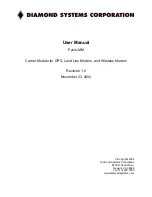
9
2.3.3 Two/Three/Four-Wire RTD
The figures below show the input connections and input connector jumpers
(shown in bold lines) required to hookup a 2-, 3- or 4-wire RTD.
Figure 2.5 a) RTD-1000 ohm and
b) RTD-100 ohm Wiring Hookup
500 ohm Wiring Hookup
The
two-wire
connection is simplest method, but does not compensate for
lead-wire temperature change and often requires calibration to cancel lead-wire
resistance offset.
The
three-wire
connection works best with RTD leads closely equal in
resistance. The device measures the RTD, plus upper and lower lead drop
voltage and the subtracts twice the measured drop in the lower supply current
lead producing excellent lead-resistance cancellation for balanced
measurements.
The
four-wire
RTD hookup is applicable to unbalanced lead resistance and
enables the device to measure and subtract the lead voltage, which produces
the best lead-resistance cancellation.
When configuring your controller, select
RTD Type
and
RTD value
in the Input
Type menu (see
Part 3
).
If the input wires of the meter get disconnected or broken, it will display
+OPN
“Input (+) Open” message except in case of 500/1000 Ω 2-wire
RTD. In this case the display shows
-OPN
“Input (-) Open” message.
For safety purpose you may want to set up your alarm to be triggered
when input is open. See Alarm 1 and 2 chapters for details.
2-WIRE
4-WIRE
3-WIRE
2-WIRE
4-WIRE
3-WIRE














































